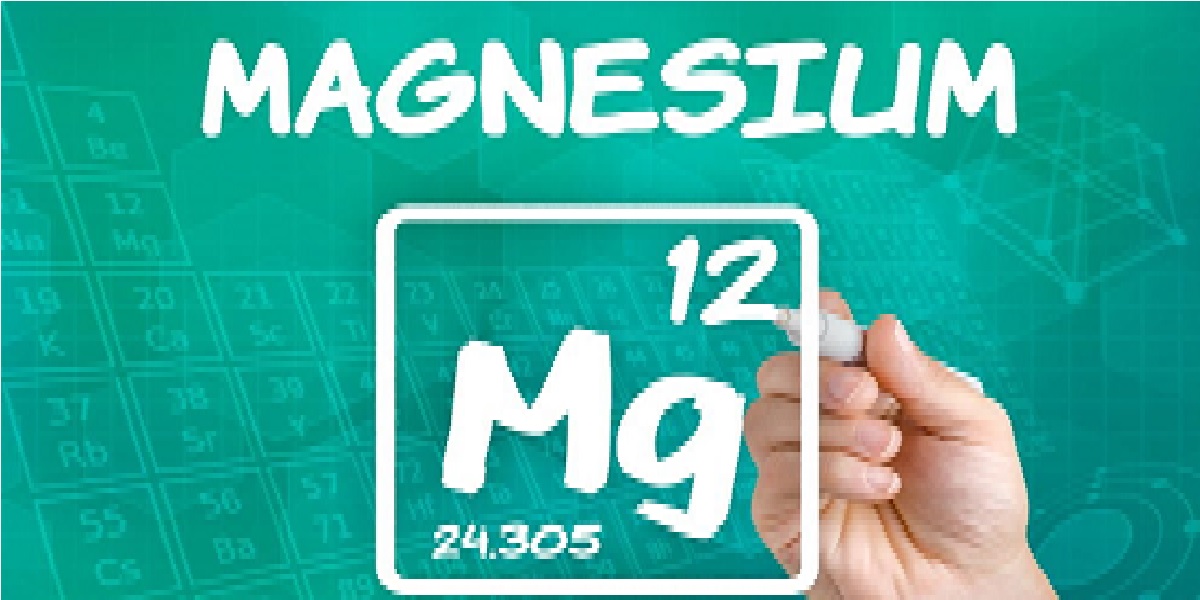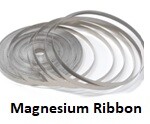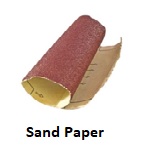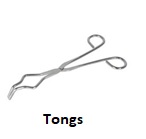Magnesium is a chemical element with the symbol Mg and atomic number 12. The metal is highly flammable and reactive in nature.
Some interesting facts about Magnesium:
- Magnesium is the ninth most abundant element (present in large quantities) in the universe and eighth most abundant in earth’s crust making about 13% of the planet’s mass. It is also the third most abundant element dissolved in sea water, after sodium and chlorine.
- Magnesium is the eleventh most abundant element by mass in the human body and is essential to all cells and some enzymes.
- Magnesium in elementary form exists as gray-white light-weight metal. Compared to all the alkaline earth metals, Magnesium has the lowest melting point (923 K (1,202 °F)) and the lowest boiling point 1,363 K (1,994 °F).
- Magnesium is highly flammable. Flame temperatures of magnesium and magnesium alloys can reach 3,100 °C (5,610 °F). Once ignited, such fires are difficult to extinguish, because combustion continues in nitrogen (forming magnesium nitride), carbon dioxide (forming magnesium oxide and carbon), and water (forming magnesium oxide and hydrogen, which also combusts due to heat in the presence of additional oxygen).
- Magnesium plays an important role in about 300 enzyme reactions in human body like synthesis of proteins, nerve & muscle function, blood glucose and blood pressure regulation. An adult body contains approximately 25g magnesium with 50% to 60% present in the bones and most of the rest in soft tissues
Burning of Magnesium Ribbon:
When the magnesium is burnt, it reacts with oxygen present in the air to form a compound, magnesium oxide. The reaction produces a bright white dazzling light while converting magnesium into magnesium oxide powder. This oxidation or combustion of magnesium has been used a source of intense light in photography and in other photochemical reactions. Following are the steps to perform the experiment:
Precautions: Wear safety glasses and hand gloves before performing the experiment.
Apparatus Required
Step wise Procedure
1. Rubbing of Magnesium Ribbon with Sand Paper: Magnesium due to its reactive nature gets coated with rust and carbon in air. The coating needs to be removed before burning. Sand paper is used for the purpose and ribbon is rubbed as shown in the image.
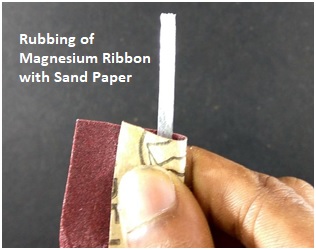
2. Burning of Magnesium Ribbon: Use to the tongs to hold the ribbon and spirit lamp to burn the metal. Hold the Mg ribbon on fire for some time till it catches fire.
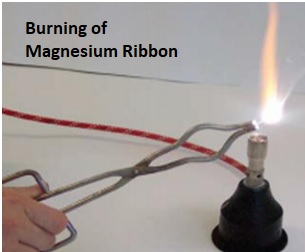
3. Observe the white light: When Magnesium ribbon starts burning; a bright white dazzling light is produced. Use safety glasses to watch the flame.
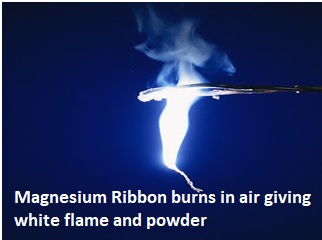
4. Formation of Magnesium Oxide: After the magnesium ribbon has burnt, a white substance is formed in powdered form, called magnesium oxide. The reaction follows:
2Mg (s) + 2O2 (g) → 2MgO (s)
Melting Point of Mg (650oC) → Melting Point of MgO (2852oC)
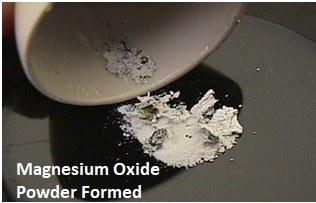
5. Formation of Magnesium Hydroxide: Collect the powdered magnesium oxide in watch glass. Add some water to it. A new compound magnesium hydroxide will be formed as shown in reaction:
MgO (s) + H2O (l) → Mg (OH)2 (s)
6. Test Magnesium Hydroxide for base or acid: Now use artificial indicator, Phenolphthalein to check the alkalinity of the compound. Add few drops of Phenolphthalein to it and observe the color changes.
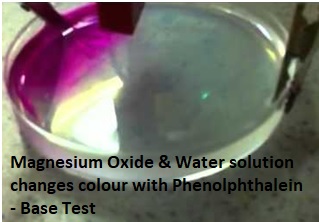
Applications of Magnesium Oxide Powder:
- Antacids: Being basic in nature, in its hydrated form, it is commonly used to neutralize the acidity and indigestion due to acidity. Milk of Magnesia is commonly used syrup in daily life.
- Drying Agent: In powdered form, magnesium oxide is hygroscopic in nature meaning that it attracts water from its surroundings. Libraries and other large book and paper storage facilities will often use powdered magnesium oxide to help preserve paper.
- Refractory: Due to its high temperature withstanding capabilities (2852oC melting point), it is used in lining the inner surface of the furnaces.
- Many other uses include dietary supplements for humans and animals, insulators, packaging of nuclear wastes, treatment of leather etc.

